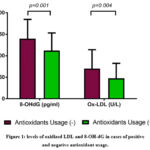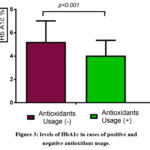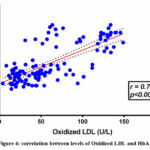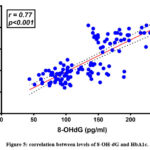Abdullatif Taha Babakr* and Mohammad Althubiti
and Mohammad Althubiti
Department of Medical Biochemistry, Faculty of Medicine, Umm Al-Qura University, Makkah, K.S.A
Corresponding Author E-mail:atbabakr@uqu.edu.sa
DOI : https://dx.doi.org/10.13005/bpj/2655
Abstract
Objectives: Oxidative stress is a major cause of many disorders. However, the benefits of antioxidant-rich diet on the situation of oxidative stress and overall health remains under continuous investigations. Saudi Dietary Guidelines (The Healthy Food Palm) recommend the highest servings of fruits and vegetables for the middle-aged Saudi men (19-50 Years). We investigated the association between antioxidant-rich diet and levels of oxidized low-density lipoprotein, 8-OH-dG, lipid profile and HbA1c in Saudi men. Method: One hundred and fourteen healthy Saudi men were enrolled. The study group was categorized into Normal diet and Antioxidant-rich diet groups. Oxidized LDL, 8-OH dG, Lipid profile, and HbA1c were measured, and statistical methods were used for correlations and comparison between the two groups. Results: Decreased levels of 8-OH-dG was observed in the antioxidant rich diet group compared to the other group; p= 0.001. Similarly, the levels of Ox-LDL were lower in the antioxidant rich diet group compared to normal group; p=0.004. Total cholesterol, Triglycerides, and LDL were found to be significantly elevated in normal group compared to antioxidant rich diet group; p>0.001. HbA1c was higher in the normal group; p>0.001. Conclusion: In conclusion, the present study suggests that antioxidant rich diet may have a positive impact on decreasing oxidized low-density lipoproteins and 8-OH-dG. Additionally, using an antioxidant rich diet may enhance the lipid profile and decrease HbA1c. Larger studies to validate these findings and explore the benefits of healthy diet are recommended.
Keywords
Antioxidants; Dyslipidemia; Oxidized LDL; 8-OH-Dg; Oxidative Stress
Download this article as:| Copy the following to cite this article: Babakr A. T, Althubiti M. Impact of Antioxidant-Rich Diet on Decreasing Oxidized Low-Density Lipoproteins, 8-Hydroxy-2´-Deoxyguanosine and Hba1c in Saudi Men. Biomed Pharmacol J 2023;16(2). |
| Copy the following to cite this URL: Babakr A. T, Althubiti M. Impact of Antioxidant-Rich Diet on Decreasing Oxidized Low-Density Lipoproteins, 8-Hydroxy-2´-Deoxyguanosine and Hba1c in Saudi Men. Biomed Pharmacol J 2023;16(2). Available from: https://bit.ly/3pzykbc |
Introduction
Oxidative stress is a major cause of many illnesses, from cardiovascular diseases to cancer 1,2. As an agreed defense strategy against this, many people take dietary antioxidant supplements, like vitamins and minerals, to increase their antioxidant defense. In recent years, nutritionists and health experts have been touting the benefits of a diet rich in antioxidants 3. Antioxidants can help reverse the effects of oxidative stress, which is caused by harmful free radicals. A diet rich in antioxidants can offer a range of health benefits, from reduced risk of chronic disease and improved cognitive function to improved skin health, quality of sleeping, and better digestion 4.
Millions of people worldwide are affected by hyperlipidemia 5. People with dyslipidemia are more susceptible to thrombosis. Oxidized low-density lipoprotein, have been linked to the emergence of a pro-thrombotic condition according to earlier research 6. Causal relationship between endothelial dysfunction and oxidized LDL has been proven in previous studies 7,8. The use of these pathogenic particles as biomarkers of cardiovascular diseases was suggested in previous work 9.
One of the most well-known biomarkers of oxidative DNA damage is 8-hydroxy-2-deoxyguanosine, which is produced after the repair of DNA damage brought on by free radicals and reactive oxygen species. Previous studies have demonstrated a strong correlation between DNA damage and atherosclerosis and heart failure 10. Significant association was reported between DNA damage and the incidence of atherosclerosis and heart failure 11
The importance of healthy eating habits has long been recognized and the benefits of a nutritious diet are undeniable. Recent research has indicated that foods with a high content of antioxidants can have positive effects on health outcomes 12-14. The health benefits of consuming an antioxidant-rich diet are becoming increasingly clear 15. Antioxidants are powerful molecules that protect cells from free radical damage which may lead to chronic diseases including cardiovascular diseases and diabetes mellitus 16,17. The importance of a healthy diet in curing or prevention of various diseases cannot be understated. However, the effects of an antioxidant-rich diet on oxidative stress and overall health remains unclear. In the present study, we investigate the influence of an antioxidant-rich diet on oxidized low-density lipoproteins and 8-OH-dG, two biomarkers of oxidative stress, and its prospected effect on lipid profile and of HbA1c.
Methods of the study
One hundred and fourteen healthy Saudi men were enrolled in this study. Makka Al-Mukarama, Saudi Arabia, was the location of the study population. All individuals who met the inclusion criteria provided ethical approval; those who used antioxidant supplements or medications were excluded. The Biomedical Ethics Committee, College of Medicine, Umm Al-Qura University, Makka Al-Mukarama, Saudi Arabia, approved the study methodology and overall procedures.
All respondents received instructions to answer questions about a meal frequency questionnaire to determine their regular food intake. Age and personal lifestyle information, including dietary habits, were also obtained. Antioxidant-rich diet was assessed using both the Dietary Guidelines for Saudis 18 and recommendation of using “High antioxidant claims” in food. The population of the study was categorized into two groups of normal diet and antioxidant-rich diet.
Measurements of BMI were obtained and clinical assessments were performed for inclusion criteria. After 12 hours of fasting, blood samples were obtained for following the standard procedures of venipuncture assessment of 8-OH-dG, oxidized LDL, Triglycerides, Total cholesterol, HDL, LDL, and HbA1c.
The chemical analyzer (Humastar-80), a fully automated equipment from Human Diagnostics in Wiesbaden, Germany, was used for routine lipid profile analysis and HbA1c. The procedures and controls were carried out in accordance with the manufacturer’s instructions, using Human Diagnostics’ kits and standards in Wiesbaden, Germany.
We used the Mercodia Oxidized LDL kit to test Oxidized Low-Density Lipoproteins. The Competitive ELISA technique, as described in the test kit produced by Mercodia AB, Sylveniusgatan 8A, SE-754 50 Uppsala, Sweden (CV8%). The Holvoet et al monoclonal antibody, 4E6, is used in this ELISA approach. To create the antigen-antibody complex, the particular antibody targets oxidatively impaired LDL. 19. 4E6 antibody is directed against the LDL protein apoB-100, which has changed shape. Oxidized LDL competes with a predetermined quantity of oxidized LDL attached to the plate’s wells. The standard curve may then be used to calculate ox-LDL levels.
Cloud-Clone Crop 8-OH-dG was used to assess 8-OH-dG. According to the manufacturer, the approach is a Competitive inhibition ELISA technique from (Cloud-Clone Crop., USCN Life science Inc.; Houston, TX 77,082, USA), and the kit was designed to be used for quantitative determination of 8-OH-dG in human blood serum (CV10%). A microplate pre-coated with a monoclonal antibody specific to 8-OH-dG was employed. The pre-coated antibody specific to 8-OH-dG was then used to begin a competitive inhibitory reaction between biotin labeled 8-OH-dG and unlabeled 8-OH-dG in the standards or samples. The unbound conjugate was eliminated in the following washing. After that, each microplate well was treated for 30 minutes at 37 °C with avidin coupled to horseradish peroxidase (HRP). 8-OH-dG. concentration in the sample was then obtained using the standard curve in pg/ml. the wavelength used in measurements was 450 nm as per the kit booklet.
Statistical analysis
For statistical analysis of the acquired data, the Statistical Package for the Social Sciences (SPSS) for Windows version 20 was used. The results of each parameter were presented as mean ±SD. We generated data tables for the antioxidant rich diet and normal diet groups using descriptive statistics, mean procedures, and an independent sample t-test to compare the various means across groups. Pearson correlation coefficient is used to assess the relationship between several measured lipid and HbA1c parameters and oxidative stress measures oxidized LDL and 8-OH dG. P<0.05 has been considered statistically significant in all statistical techniques.
Results
Among the one hundred and fourteen subjects recruited in the present study, forty-seven (41.2%) were categorized as antioxidant rich diet group, while the remaining sixty-seven (58.8%) were categorized in the group of normal diet as shown in table 1, according to the dietary habits reported in the questionnaire. There was no significant difference between the two groups in age or BMI.
Decreased levels of 8-OH dG was observed in the group of antioxidant rich diet compared to the other group (112.23 ± 41.01 ng/ml and 139.87 ± 44.64 ng/ml, respectively) p = 0.001. Similarly, the levels of Ox-LDL were found to be (47.73 ± 34.84 and 70.30 ± 43.94 U/L) in the antioxidant rich diet group and normal group respectively, p = 0.004.
Regarding the lipid profile parameters, levels of Total cholesterol, Triglycerides, and LDL were found to be significantly elevated in normal group (218.24 ± 44.04, 128.10 ± 63.72, and 140.80 ± 28.41 mg/dl, respectively), compared to lower levels of these parameters in antioxidant rich diet group, where Total cholesterol, Triglycerides, and LDL were found to be ((183.55 ± 12.89, 89.62 ± 28.64, and 119.76 ± 11.24 mg/dl, respectively), p>0.001. Unexpected increased levels of HDL were observed in the normal group (52.50 ± 11.29 mg/dl) compared to antioxidant rich diet subjects (45.40 ± 5.91 mg/dl), p>0.001.
HbA1c was higher in the normal group (5.21 ± 1.8%) compared to the antioxidant rich diet group (4.04 ± 1.37%) p>0.001.
Discussion
The cultural heritage of each country and society has influenced people`s dietary habits for people of this country or society. Saudi Arabia, with its diverse cultures, is not an exception. However, with the emergence of a global network of fast-food companies, a great legacy of diverse dietary habits is at stake. It is undeniable that humankind has survived by overcoming various illnesses and diseases with healthy diet and medicinal herbs throughout history, and knowledge accumulated over thousands of years is our present heritage. Endogenous antioxidant mechanisms can be inefficient to maintain the required oxidant/antioxidant balance. Therefore, the quest to investigate natural antioxidant sources is important.
The Kingdom of Saudi Arabia has undergone significant economic and social transformations accompanied by change of dietary habits over the past few decades. The Dietary Guidelines for Saudis, 2012 aiming at promoting citizens’ awareness of what to eat, recommend 8-10 servings of fruits and vegetables daily for the age group of 19 – 50 years 18.
In the present study, decreased levels of Ox-LDL and 8-OH dG were observed in the group of dietary habits rich in antioxidant sources as shown in figure 1, suggesting a beneficial role of this lifestyle in decreasing the oxidative stress biomarkers.
 |
Figure 1: levels of oxidized LDL and 8-OH-dG in cases of positive and negative antioxidant usage. |
Since many of previous Studies have shown that elevated levels of oxidized low-density lipoproteins and 8-hydroxydeoxyguanosine are associated with oxidative stress 20-22. Additionally, higher levels of 8-OH dG and oxidized LDL are associated with a greater risk of developing many pathologic conditions including cancer 23 cardiovascular disease [24], and DNA damage 2, 25. Therefore, an antioxidant rich diet may help in prevention of these pathologic scenarios.
The current study’s findings were similar with prior research that looked at the impact of an antioxidant-rich diet on these indicators. According to Hector Diaz-Garcia and colleagues, the levels of 8-OHdG were only significantly lower in neonates from moms who consumed more vitamin A and E 26. Many prior studies in this field found that various dietary components from natural sources (e.g., tocopherols, ascorbic acid, carotenoids) have high antioxidant effects against ox-LDL and DNA oxidative damage both in vitro and in vivo 27.
As reported in early studies, consuming recommended quantities of fruits and vegetables can significantly lead to reduction of oxidative stress. H. J. Thompson and colleagues reported significant reduction in urinary 8-isoprostane F2α, a marker of oxidative stress, in women who consumed higher amounts of fruits and vegetables 28.
The high intake of antioxidants recommended by Saudi Dietary Guidelines (The Healthy Food Palm) for the middle-aged Saudi men seems to be justified according to the findings of the present study which recruits men of age group (41.43 + 11.71) and (39.85 + 11.71) in the two study groups as shown in table 1, and these results agree with the previous findings of other teams who investigate the impact of antioxidant rich diet in adolescent. In a previous study recruited two hundreds eighty-five adolescent boys and girls, Holt et al. 29 demonstrate a significant inverse correlation between the levels of urinary F2-isoprostane and the intake of fruits and vegetables. Levels of C-reactive protein concentration, as a marker of inflammation, were also inversely correlated with intake of fruits, vitamin C, and folate. All these findings demonstrate favorable effects of fruits and vegetables on the overall health especially oxidative stress and inflammation. lower levels of F2-isoprostane were also reported in premenopausal women who consume five servings of fruits and vegetables per day 30.
Table 1: Age, BMI, HbA1c, Lipid profile and 8-OH-dG in subjects with and without antioxidant usage.
|
Group Statistics |
|||||
|
Antioxidant usage |
N |
Mean |
Std. Deviation |
p-value |
|
|
Age (Yrs.) |
Negative |
67 |
41.43 |
11.83 |
0.281 |
|
Positive |
47 |
39.85 |
11.71 |
||
|
BMI (Kg/m2) |
Negative |
67 |
27.31 |
2.6 |
0.269 |
|
Positive |
47 |
26.79 |
2.21 |
||
|
8-OHDG (pg/ml) |
Negative |
67 |
139.87 |
44.64 |
0.001 |
|
Positive |
47 |
112.23 |
41.01 |
||
|
Ox-LDL (U/L) |
Negative |
67 |
70.30 |
43.94 |
0.004 |
|
Positive |
47 |
47.73 |
34.84 |
||
|
Cholesterol (mg/dl) |
Negative |
67 |
218.24 |
44.04 |
<0.001 |
|
Positive |
47 |
183.55 |
12.89 |
||
|
Triglycerides (mg/dl) |
Negative |
67 |
128.10 |
63.72 |
<0.001 |
|
Positive |
47 |
89.62 |
28.64 |
||
|
HDL-C (mg/dl) |
Negative |
67 |
52.50 |
11.29 |
<0.001 |
|
Positive |
47 |
45.40 |
5.91 |
||
|
LDL-C (mg/dl) |
Negative |
67 |
140.80 |
28.41 |
<0.001 |
|
Positive |
47 |
119.76 |
11.24 |
||
|
HbA1c (%) |
Negative |
67 |
5.21 |
1.80 |
<0.001 |
|
Positive |
47 |
4.04 |
1.37 |
||
Results are expressed as mean ±SD.
Oxidative stress is linked to cardiovascular disease, as it triggers the oxidation of LDL particles and 8-OH dG molecules. This is a natural process that results from exposure to free radicals and other reactive oxygen species. The oxidation of LDL particles and 8-OH dG molecules can raise the risk of cardiovascular disease and many pathologic scenarios, so it’s important to bring down oxidative stress especially by healthy dietary lifestyles to lower this risk.
The present study suggested that a strong and significant association exists between antioxidant rich diet and lipid profile parameters as shown in figure 2. The antioxidant rich diet group shows decreased total cholesterol, LDL, and triglyceride values compared to normal diet group.
 |
Figure 2: lipid profile in cases of positive and negative antioxidant usage. |
These results agree with the reported health benefits of antioxidant rich food on dyslipidemia. Chung, and colleagues demonstrate that consuming an antioxidant-rich diet for four weeks improves the oxidative stress status and dyslipidemia in aged Koreans with Metabolic syndrome. 31. Moreover, the mechanisms used by antioxidants food to protect patients with dyslipidemia from the related consequences include modification of lipid homeostasis, antioxidant activity, and anti-inflammatory activities, according to sixteen reviewed research. 32. The good health outcomes of antioxidant rich diet extended to enhance glycemic status of individuals as reflected in the present study by low percent of HbA1c in this group compared to their peers of normal diet group as shown in figure 3. The present study suggests that better glycemic control is observed in the group of anti-oxidant rich dite.
 |
Figure 3: levels of HbA1c in cases of positive and negative antioxidant usage. |
Moreover, a significant positive association was observed between HbA1c, and oxidative stress parameters ox-LDL as shown in figure 4, and 8-OH dG as shown in figure 5. These finding were in consistent with previous work. Kahleova, and colleagues suggested that vegetarian diet may have beneficial impact on oxidative stress, and may improves insulin resistance and oxidative stress markers more than conventional diet in subjects with Type2 diabetes 33
 |
Figure 4: correlation between levels of Oxidized LDL and HbA1c. |
 |
Figure 5: correlation between levels of 8-OH-dG and HbA1c. |
Among the package of dietary recommendations for diabetic patients, the antioxidant rich diet remains the most important to lower the risk of serious complications of the disease.
Conclusion
In conclusion, the current study demonstrates that an antioxidant-rich diet may have a positive impact on reducing oxidative stress markers such as oxidized low density lipoproteins and 8-OH dG. Furthermore, eating an antioxidant-rich diet may improve the lipid profile and lower HbA1c. More research is needed to verify these findings and elucidate the processes behind these correlations.
Conflict of Interests
The authors declare that there is no conflict of interests regarding the publication of this paper.
Funding Sources
The authors would like to thank the Deanship of Scientific Research at Umm Al-Qura University for supporting this work by Grant Code: (22UQU4300045DSR04).
References
- D. M. Teleanu et al., “An Overview of Oxidative Stress, Neuroinflammation and Neurodegenerative Diseases,” Int J Mol Sci, vol. 23, no. 11, Jun. 2022, doi: 10.3390/ijms23115938.
CrossRef - T. Senoner and W. Dichtl, “Oxidative stress in cardiovascular diseases: Still a therapeutic target?,” Nutrients, vol. 11, no. 9, Sep. 2019, doi: 10.3390/nu11092090.
CrossRef - B. L. Tan, M. E. Norhaizan, and W. P. P. Liew, “Nutrients and oxidative stress: Friend or foe?,” Oxid Med Cell Longev, vol. 2018, 2018, doi: 10.1155/2018/9719584.
CrossRef - W. Lu et al., “Antioxidant activity and healthy benefits of natural pigments in fruits: A review,” International Journal of Molecular Sciences, vol. 22, no. 9. MDPI AG, May 01, 2021. doi: 10.3390/ijms22094945.
CrossRef - S. Fischer, U. Schatz, and U. Julius, “Practical recommendations for the management of hyperlipidemia,” Atheroscler Suppl, vol. 18, pp. 194–198, 2015, doi: 10.1016/j.atherosclerosissup.2015.02.029.
CrossRef - A. P. Owens 3rd, J. R. Byrnes, and N. Mackman, “Hyperlipidemia, tissue factor, coagulation, and simvastatin,” Trends Cardiovasc Med, vol. 24, no. 3, pp. 95–98, 2014, doi: 10.1016/j.tcm.2013.07.003.
CrossRef - A. Trpkovic et al., “Oxidized low-density lipoprotein as a biomarker of cardiovascular diseases,” Crit Rev Clin Lab Sci, vol. 52, no. 2, pp. 70–85, 2015, doi: 10.3109/10408363.2014.992063.
CrossRef - H. Ghazizadeh et al., “Pro-oxidant–antioxidant balance (PAB) as a prognostic index in assessing the cardiovascular risk factors: A narrative review,” Obes Med, vol. 19, p. 100272, Sep. 2020, doi: 10.1016/J.OBMED.2020.100272.
CrossRef - A. Mertens and P. Holvoet, “Oxidized LDL and HDL: antagonists in atherothrombosis,” FASEB J, vol. 15, no. 12, pp. 2073–2084, 2001, doi: 10.1096/fj.01-0273rev.
CrossRef - A. Di Minno et al., “8-Hydroxy-2-Deoxyguanosine Levels and Cardiovascular Disease: A Systematic Review and Meta-Analysis of the Literature,” Antioxid Redox Signal, vol. 24, no. 10, pp. 548–555, 2016, doi: 10.1089/ars.2015.6508.
- A. Di Minno et al., “8-Hydroxy-2-deoxyguanosine levels and heart failure: A systematic review and meta-analysis of the literature,” Nutr Metab Cardiovasc Dis, vol. 27, no. 3, pp. 201–208, 2017, doi: 10.1016/j.numecd.2016.10.009.
CrossRef - M. Kanjilal, U. Kumar, G. K. Gupta, D. Agrawal, R. K. Arya, and J. Batra, “Dietary Habits and their Impact on the Physical Status of School Going Adolescents in Delhi: A Cross-sectional Study,” JOURNAL OF CLINICAL AND DIAGNOSTIC RESEARCH, 2021, doi: 10.7860/jcdr/2021/48202.15158.
CrossRef - R. Trigueros et al., “The influence of the trainer’s social behaviors on the resilience, anxiety, stress, depression and eating habits of athletes,” Nutrients, vol. 12, no. 8, 2020, doi: 10.3390/nu12082405.
CrossRef - A. R. Seo and T. Y. Hwang, “Relationship between dietary patterns and cardiovascular disease risk in Korean older adults,” Int J Environ Res Public Health, vol. 18, no. 7, 2021, doi: 10.3390/ijerph18073703.
CrossRef - P. C. Wootton-Beard and L. Ryan, “Improving public health?: The role of antioxidant-rich fruit and vegetable beverages,” Food Research International, vol. 44, no. 10. 2011. doi: 10.1016/j.foodres.2011.09.015.
CrossRef - U. Asmat, K. Abad, and K. Ismail, “Diabetes mellitus and oxidative stress—A concise review,” Saudi Pharmaceutical Journal, vol. 24, no. 5. 2016. doi: 10.1016/j.jsps.2015.03.013.
CrossRef - Md. S. I. Arman, “Free radical, oxidative stress and diabetes mellitus: A mini review,” Discovery Phytomedicine, vol. 6, no. 3, 2019, doi: 10.15562/phytomedicine.2019.98.
CrossRef - M. Hamad Al-Dkheel, “Dietary Guidelines for Saudis,” 2012. Accessed: Feb. 14, 2023. [Online]. Available: https://www.moh.gov.sa/en/ HealthAwareness/ Pages/SaudihealthFoodGuide.aspx
- P. Holvoet et al., “Analytical performance and diagnostic accuracy of immunometric assays for the measurement of circulating oxidized LDL,” Clin Chem, vol. 52, no. 4, pp. 760–764, 2006, doi: 10.1373/clinchem.2005.064337.
CrossRef - P. G. Cocate et al., “Fruit and vegetable intake and related nutrients are associated with oxidative stress markers in middle-aged men,” Nutrition, vol. 30, no. 6, pp. 660–665, 2014, doi: 10.1016/j.nut.2013.10.015.
CrossRef - O. Zengi, A. Karakas, U. Ergun, M. Senes, L. Inan, and D. Yucel, “Urinary 8-hydroxy-2′-deoxyguanosine level and plasma paraoxonase 1 activity with Alzheimer’s disease,” Clin Chem Lab Med, vol. 50, no. 3, pp. 529–534, Mar. 2012, doi: 10.1515/cclm.2011.792.
CrossRef - N. Hermans et al., “A red yeast rice-olive extract supplement reduces biomarkers of oxidative stress, OxLDL and Lp-PLA2, in subjects with metabolic syndrome: A randomised, double-blind, placebo-controlled trial,” Trials, vol. 18, no. 1, Jul. 2017, doi: 10.1186/s13063-017-2058-5.
CrossRef - A. Valavanidis, T. Vlachogianni, and C. Fiotakis, “8-Hydroxy-2′ -deoxyguanosine (8-OHdG): A critical biomarker of oxidative stress and carcinogenesis,” J Environ Sci Health C Environ Carcinog Ecotoxicol Rev, vol. 27, no. 2, pp. 120–139, May 2009, doi: 10.1080/10590500902885684.
CrossRef - L. J. Kroese and P. G. Scheffer, “8-Hydroxy-2′-Deoxyguanosine and Cardiovascular Disease: a Systematic Review,” Curr Atheroscler Rep, vol. 16, no. 11, pp. 1–8, Nov. 2014, doi: 10.1007/s11883-014-0452-y.
CrossRef - A. M. Chiorcea-Paquim, “8-oxoguanine and 8-oxodeoxyguanosine Biomarkers of Oxidative DNA Damage: A Review on HPLC–ECD Determination,” Molecules, vol. 27, no. 5, Mar. 2022, doi: 10.3390/molecules27051620.
CrossRef - H. Diaz-Garcia et al., “Dietary and Antioxidant Vitamins Limit the DNA Damage Mediated by Oxidative Stress in the Mother–Newborn Binomial,” Life, vol. 12, no. 7, Jul. 2022, doi: 10.3390/life12071012.
CrossRef - S. Kiokias, C. Proestos, and V. Oreopoulou, “Effect of natural food antioxidants against ldl and dna oxidative changes,” Antioxidants, vol. 7, no. 10. MDPI, Oct. 03, 2018. doi: 10.3390/antiox7100133.
CrossRef - H. J. Thompson et al., “8-Isoprostane F 2 excretion is reduced in women by increased vegetable and fruit intake 1-3,” 2005. [Online]. Available: https://academic.oup.com/ajcn/article/82/4/768/4607469
CrossRef - E. M. Holt et al., “Fruit and Vegetable Consumption and Its Relation to Markers of Inflammation and Oxidative Stress in Adolescents,” J Am Diet Assoc, vol. 109, no. 3, 2009, doi: 10.1016/j.jada.2008.11.036.
CrossRef - S. M. Rink et al., “Self-Report of fruit and vegetable intake that meets the 5 a day recommendation is associated with reduced levels of oxidative stress biomarkers and increased levels of antioxidant defense in premenopausal women,” J Acad Nutr Diet, vol. 113, no. 6, 2013, doi: 10.1016/j.jand.2013.01.019.
CrossRef - H. K. Chung, J. H. Kim, A. Choi, C. W. Ahn, Y. S. Kim, and J. S. Nam, “Antioxidant-Rich Dietary Intervention Improves Cardiometabolic Profiles and Arterial Stiffness in Elderly Koreans with Metabolic Syndrome,” Yonsei Med J, vol. 63, no. 1, pp. 26–33, Jan. 2022, doi: 10.3349/YMJ.2022.63.1.26.
CrossRef - I. Medina-Vera et al., “Dietary strategies by foods with antioxidant effect on nutritional management of dyslipidemias: A systematic review,” Antioxidants, vol. 10, no. 2. MDPI, pp. 1–19, Feb. 01, 2021. doi: 10.3390/antiox10020225.
CrossRef - H. Kahleova et al., “Vegetarian diet improves insulin resistance and oxidative stress markers more than conventional diet in subjects with Type2 diabetes,” Diabetic Medicine, vol. 28, no. 5, pp. 549–559, May 2011, doi: 10.1111/j.1464-5491.2010.03209.x.
CrossRef
List of Abbreviations
LDL: Low Density Lipoproteins, 8-OH-dG: 8-hydroxy-2´-deoxyguanosine, Ox-LDL: Oxidized Low-Density Lipoproteins.








